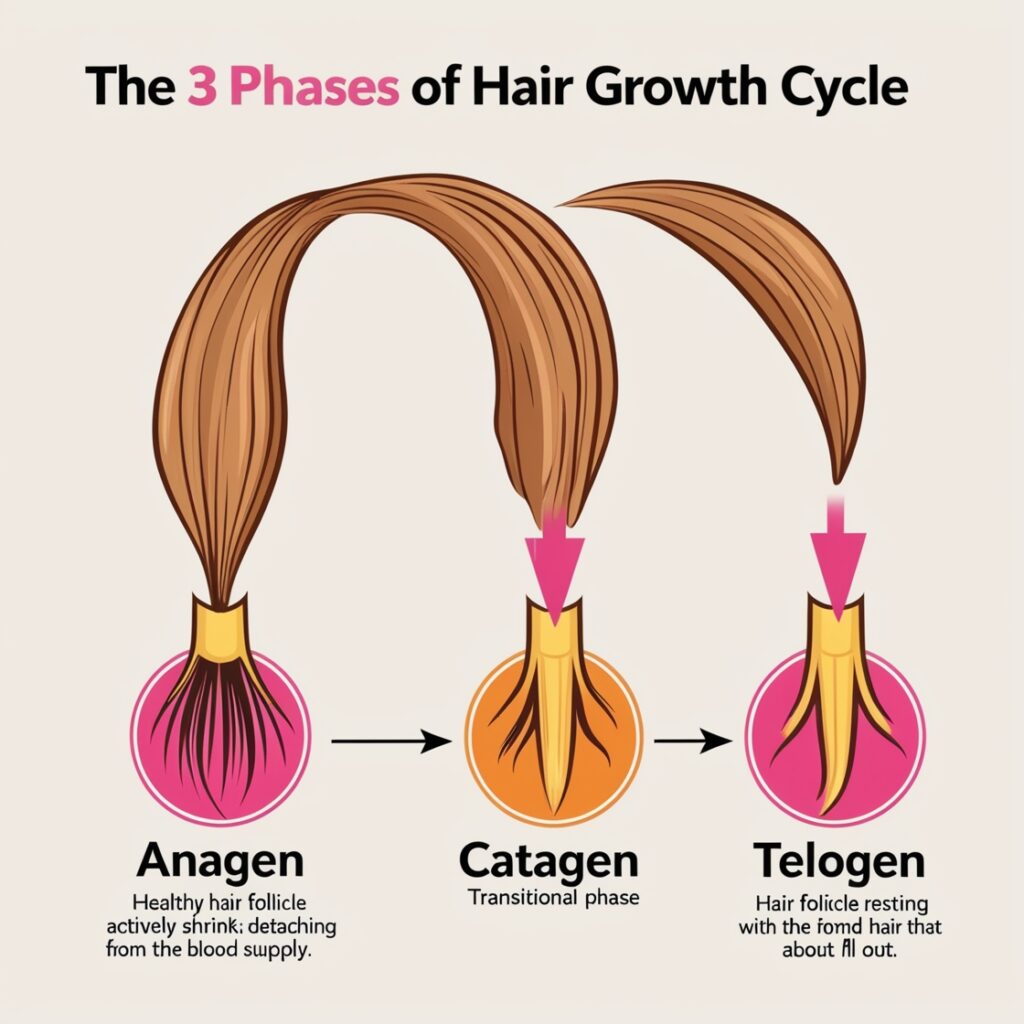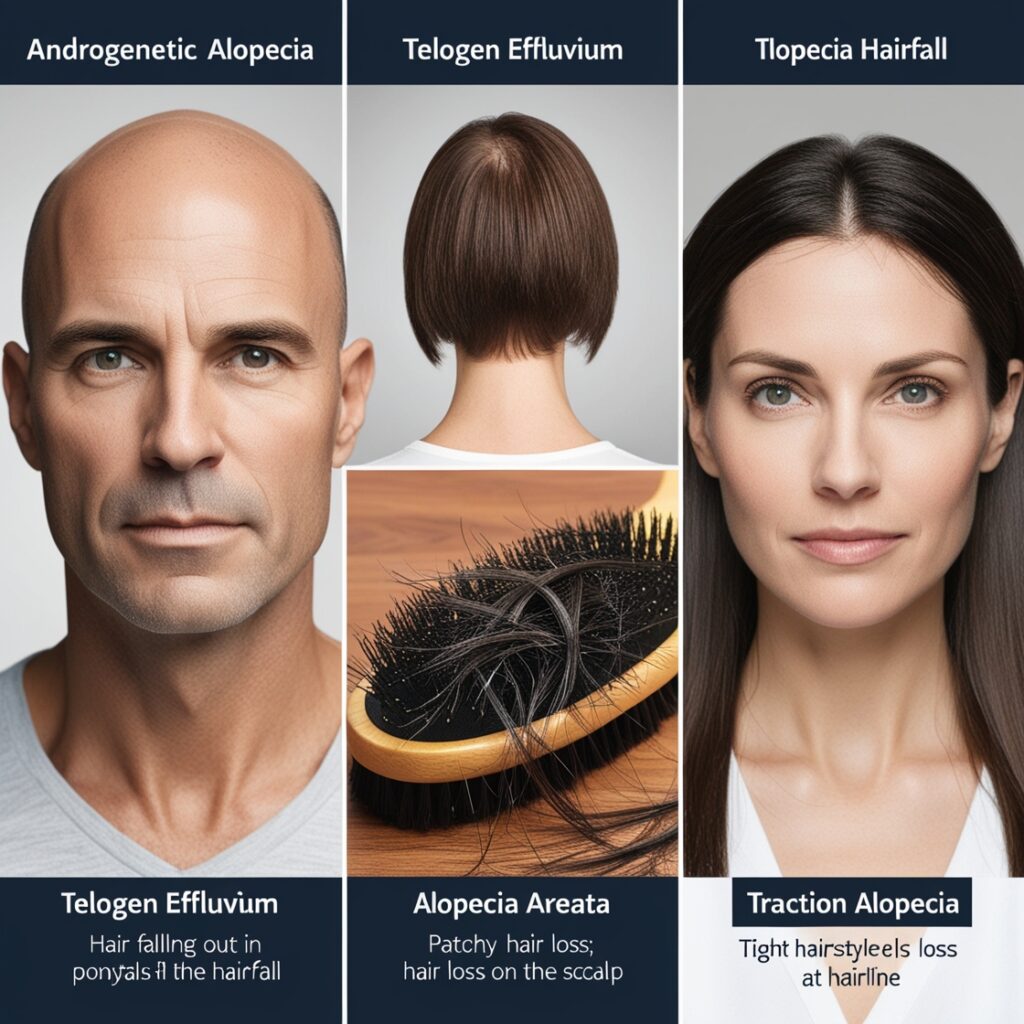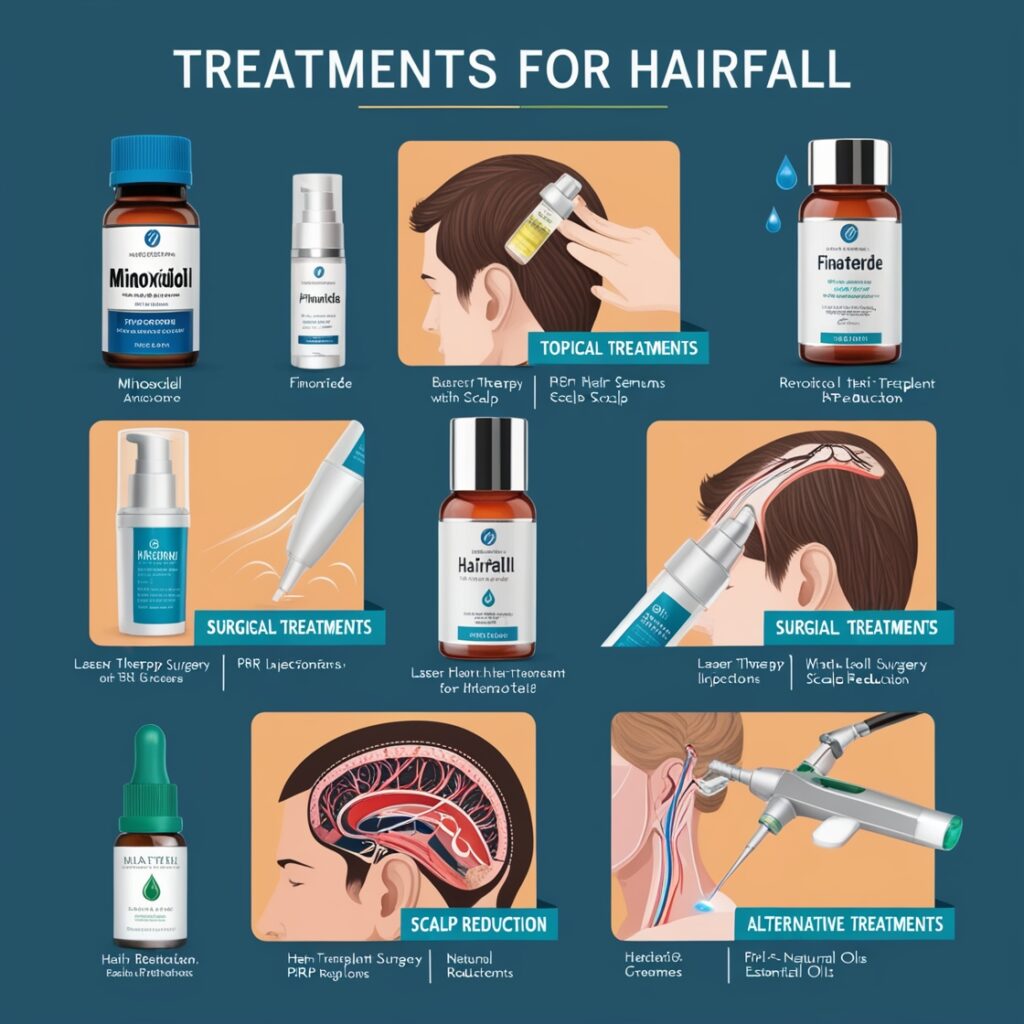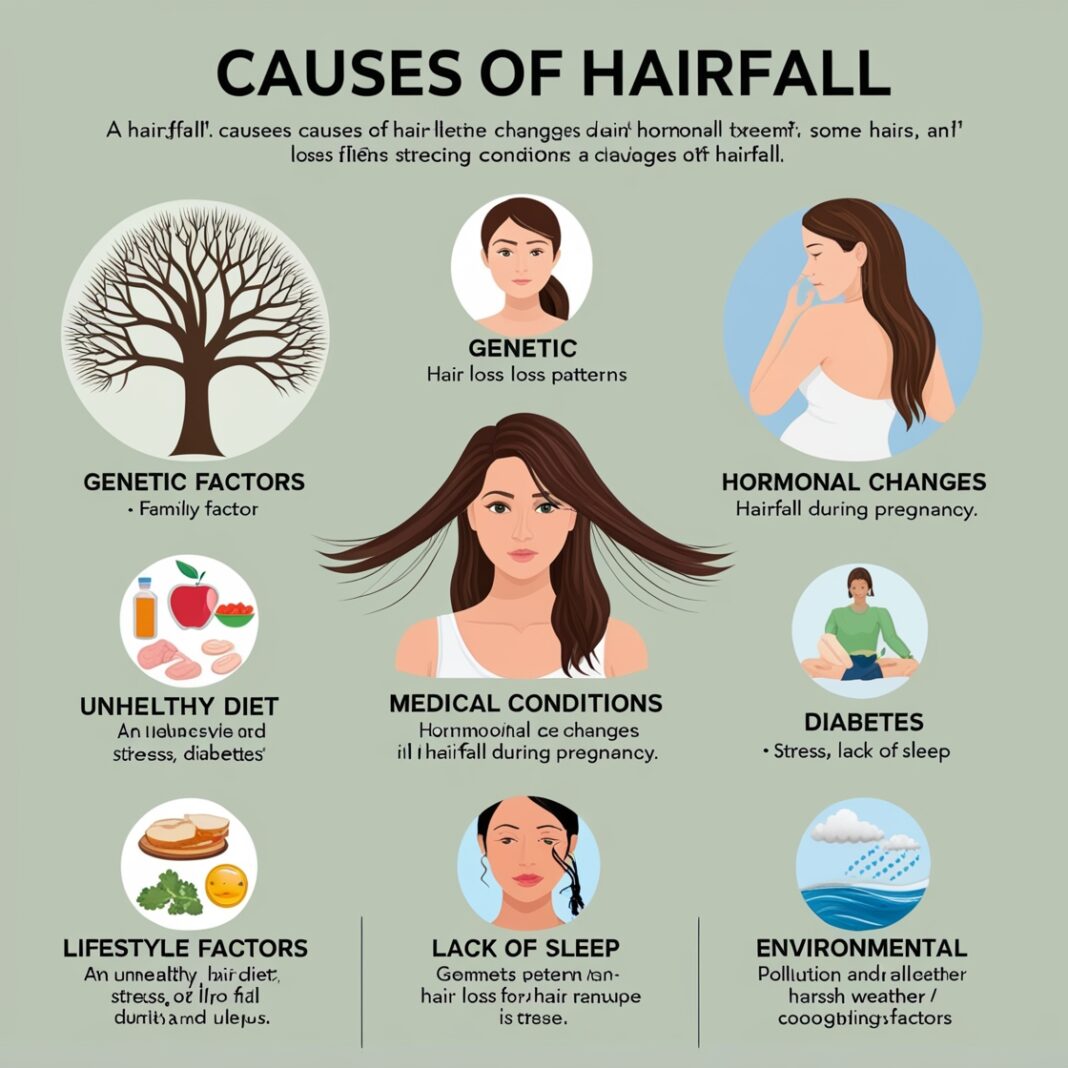Hairfall, also known as hair loss or alopecia, is a common issue affecting millions of people worldwide. It can be a source of stress and self-consciousness for those experiencing it. This blog aims to provide a comprehensive guide on hairfall, its causes, treatments, and preventive measures. By the end of this article, you will have a better understanding of how to manage and possibly prevent hairfall.
1. Introduction
Hairfall is a natural process, with everyone losing some hair daily. However, when hairfall becomes excessive, it can lead to thinning hair or baldness, affecting self-esteem and confidence. Good management of this ailment can be achieved by being aware of its underlying causes and accessible remedies.
2. Understanding Hairfall
Normal Hairfall vs. Excessive Hairfall
It is typical for the natural hair growth cycle to cause you to lose 50–100 hairs per day. On the other hand, excessive hairfall can cause baldness or hair thinning, which can lower confidence and self-esteem. Excessive hairfall can lead to noticeable thinning or bald patches.
The Hair Growth Cycle
There are three stages in the cycle of hair growth:
- Anagen (Growth Phase): This phase lasts 2-7 years and determines the hair length.
- Catagen (Transitional Phase): This short phase lasts about 2-3 weeks.
- Telogen (Resting Phase): Lasting around 3 months, after which the hair falls out and new hair begins to grow.

3. Causes of Hairfall
Genetic Factors
Genetics play a significant role in hairfall. Androgenetic alopecia, often known as male or female pattern baldness, is inherited and affects both men and women.
Hormonal Changes
Hormonal imbalances due to pregnancy, childbirth, menopause, or thyroid problems can cause hairfall. Hormones affect hair growth and can lead to temporary or permanent hair loss.
Medical Conditions
Certain medical conditions like alopecia areata, scalp infections, and diseases like lupus or diabetes can cause hairfall. Additionally, treatments such as chemotherapy for cancer can result in significant hair loss.
Lifestyle Factors
Poor diet, stress, and lack of sleep can contribute to hairfall. Nutrient deficiencies, particularly in iron, protein, and vitamins, can weaken hair and lead to hair loss.
Environmental Factors
Exposure to pollutants, harsh weather conditions, and excessive use of hair style products and appliances can damage hair, leading it to fall out.
4. Types of Hairfall
Androgenetic Alopecia
The most common type of hair loss, androgenetic alopecia, affects both men and women. Men typically experience receding hairlines and bald spots, while women notice thinning on the crown of the scalp.
Telogen Effluvium
This temporary form of hair loss occurs when a large number of hair follicles enter the telogen phase simultaneously. It can be triggered by stress, surgery, or a severe illness.
Alopecia Areata
An autoimmune disorder where the immune system attacks hair follicles, leading to patchy hair loss. In severe cases, it can progress to complete baldness (alopecia totalis) or loss of all body hair (alopecia universalis).
Traction Alopecia
Caused by hairstyles that pull tightly on the hair, such as braids, ponytails, or extensions. Over time, this can damage hair follicles and result in permanent hair loss.
Others
Other types of hair loss include cicatricial (scarring) alopecia, trichotillomania (hair-pulling disorder), and diffuse alopecia, where hair loss is spread across the scalp.

5. Diagnosis of Hairfall
Medical History
A thorough medical history helps identify any underlying health issues, family history of hair loss, and potential triggers such as recent illnesses or stress.
Physical Examination
A dermatologist will examine the scalp and hair to assess the pattern and extent of hair loss, looking for signs of inflammation, infection, or other scalp conditions.
Laboratory Tests
Blood tests can identify underlying medical conditions, nutritional deficiencies, and hormonal imbalances that may contribute to hairfall.
Scalp Biopsy
In some cases, a scalp biopsy may be necessary to examine the hair follicles and determine the cause of hair loss.
6. Treatments for Hairfall
Medications
Minoxidil
Minoxidil is an over-the-counter topical treatment that stimulates hair growth and slows hair loss. Men and women can both benefit from it. The medication is applied directly to the scalp and can take several months to show results.
Finasteride
Finasteride is a prescription medication for men that reduces hair loss by blocking the hormone responsible for hair loss. It is taken orally and has shown significant effectiveness in treating male pattern baldness.
Spironolactone
Spironolactone is used in women to treat hair loss by reducing androgen levels. It is usually recommended in cases where alternative therapies have proven ineffective.
Topical Treatments
Corticosteroids
Topical steroids can reduce inflammation and suppress the immune system, helping with conditions like alopecia areata. They are available in various forms, including creams, ointments, and injections.
Anthralin
Anthralin is a tar-like substance used to treat psoriasis and alopecia areata by affecting the immune function of the skin. It is applied to the scalp and washed off after a short period.

Surgical Treatments
Hair Transplant Surgery
Hair follicles from one part of the body are transplanted to bald areas. Two methods are follicular unit extraction (FUE) and follicular unit transplantation (FUT). This is a permanent solution for hair loss, but it can be expensive and requires a skilled surgeon.
Scalp Reduction
Scalp reduction involves removing bald areas of the scalp and stretching the remaining skin to cover the area. This procedure is less common today but can be an option for those with small areas of hair loss.
Alternative Treatments
Laser Therapy
Low-level laser therapy (LLLT) stimulates hair follicles and promotes hair growth. This non-invasive treatment is available through devices like laser combs, helmets, and caps.
Platelet-Rich Plasma (PRP)
In order to promote hair growth, PRP entails injecting a concentrated amount of the patient’s own platelets into the scalp. The procedure involves drawing blood, processing it to concentrate the platelets, and injecting the solution into the scalp.
Natural Remedies
Some people use essential oils, herbal supplements, and other natural treatments to promote hair health and growth. Popular choices include rosemary oil, peppermint oil, and saw palmetto.
7. Preventive Measures for Hairfall
Healthy Diet
A nutritious diet high in vitamins and minerals promotes the formation of good hair.Essential nutrients include:
- Protein: Hair is made of keratin, a protein, so adequate protein intake is crucial.
- Iron: Iron deficiency can lead to hair loss, so include iron-rich foods like red meat, spinach, and lentils.
- Vitamins: Vitamins A, C, D, E, and B vitamins (especially biotin) are important for hair health.
Proper Hair Care
- Gentle Washing: To keep the scalp and hair from drying out, use a gentle shampoo and stay away from hot water.
- Conditioning: Use a conditioner to keep hair moisturized and reduce breakage.
- Avoid Heat: Use of hot styling products such as curling irons, blow dryers, and straighteners should be kept to a minimum.
Stress Management
Chronic stress can contribute to hairfall. Practice stress management techniques such as yoga, meditation, and regular exercise to maintain overall health.
Avoiding Harmful Hairstyles
Avoid tight hairstyles that pull on the hair, such as braids, ponytails, and buns. Opt for loose styles to reduce tension on the hair follicles.
8. Myths and Misconceptions about Hairfall
- Myth: Hair loss is caused by wearing hats.
Fact: Wearing hats does not cause hair loss unless they are extremely tight. - Myth: Frequent shampooing causes hair loss.
Fact: Shampooing helps keep the scalp clean and healthy, which can prevent hair loss. - Myth: Hair loss only affects older people.
Fact: Hair loss can occur at any age due to various factors, including genetics and medical conditions.
9. Lifestyle Adjustments to Support Hair Health
Regular Exercise
Engaging in regular physical activity improves overall health, including hair health. Exercise increases blood flow to the scalp, providing hair follicles with essential nutrients and oxygen.
Adequate Sleep
For the body to repair and regenerate, including hair growth, sleep is essential. To promote the health of your hair, aim for 7-9 hours of good sleep each night.
Hydration
It is critical to stay hydrated for general health, which includes healthy hair. Drink plenty of water daily to keep hair follicles hydrated and functioning properly.
Avoiding Smoking and Alcohol
Smoking and binge drinking have been shown to have detrimental effects on hair health. Both habits can reduce blood flow to the scalp, leading to hair loss. Hair health can be enhanced by giving up smoking and consuming alcohol in moderation.
10. Psychological Impact of Hairfall
Emotional Effects
Hairfall can significantly impact a person’s self-esteem and confidence. It can lead to feelings of embarrassment, anxiety, and depression. It’s important to acknowledge these emotions and seek support from friends, family, or a mental health professional.
Coping Strategies
- Support Groups:Getting involved in a support group helps foster understanding and a sense of community.
- Counseling: Speaking with a therapist can help address the emotional impact of hairfall.
- Positive Self-Talk: Practicing positive affirmations and self-compassion can improve self-esteem.

11. Future Trends in Hair Loss Treatment
Advances in Stem Cell Research
Stem cell therapy holds promise for hair loss treatment. Researchers are exploring ways to use stem cells to regenerate hair follicles and promote hair growth.
Genetic Engineering
Genetic engineering techniques, such as CRISPR, may offer future solutions for hair loss by targeting specific genes responsible for hair growth and loss.
Personalized Medicine
Advances in personalized medicine may lead to tailored treatments based on an individual’s genetic makeup, providing more effective and targeted solutions for hair loss.
12. Conclusion
Hairfall is a common issue with multiple causes, including genetics, hormonal changes, medical conditions, lifestyle factors, and environmental influences. Understanding the type and cause of hair loss is crucial for effective treatment and prevention. By adopting a healthy diet, proper hair care practices, and stress management techniques, you can help reduce hairfall and promote healthy hair growth. Consult a healthcare professional or dermatologist for personalized advice and treatment options tailored to your specific needs.
By following the tips and treatments outlined in this guide, you can take control of your hair health and address hairfall effectively. Remember, early intervention is key to preventing and managing hair loss. Take proactive steps today to maintain a healthy head of hair and boost your confidence.
